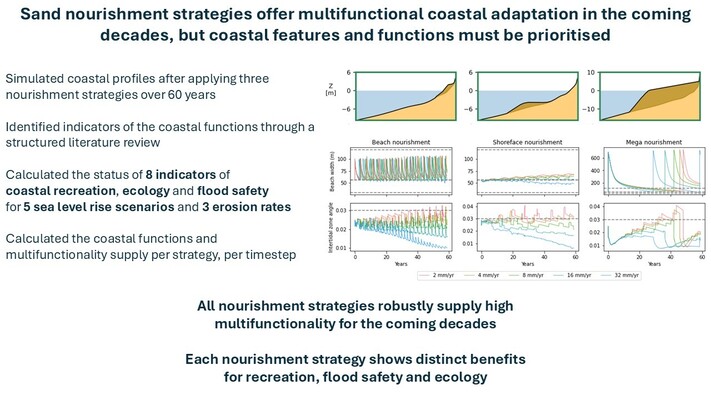H.H. Geukes1*, T.T. Kettler2 , M.A. de Schipper2, P.M. van Bodegom1, A.P.E. van Oudenhoven1
1 Leiden University, the Netherlands; 2 Delft University of Technology, the Netherlands
* Corresponding author: h.h.geukes@cml.leidenuniv.nl
Introduction
Coastal climate change impacts such as sea level rise, extreme weather events and erosion rates increase and threaten the multiple functions that coastal areas offer. Therefore, there is a global, growing need for multifunctional coastal climate adaptation of sandy shores. Coastal engineering worldwide is increasingly embracing nature-based approaches for such adaptation. Especially sand nourishment strategies are increasingly regarded as promising and innovative multifunctional adaptation tools, as they may increase flood prevention and mitigate erosion while enhancing recreational and ecological functioning. However, their multifunctional potential has not yet been assessed under diverse climate impacts at decadal scales.
Objective and Methods
Using a systems-based approach, this study aimed to identify the effects of beach, shoreface and mega-nourishment strategies on coastal multifunctionality. We identified indicators for recreational, ecological and flood safety functions through a structured literature review. We integrated these indicators into a diffusion-based cross-shore sand distribution model for dissipative coastal profiles that was developed by Kettler et al. (2024). Thereby, we simulated indicator states as the coastal profile responded to the nourishment strategies under five sea level rise scenarios and three erosion rates, and calculated the extent to which coastal functions and multifunctionality were supplied over six decades.
Results
We found that all three nourishment strategies could supply coastal multifunctionality to a high extent over the coming six decades, although the drivers of this potential differed per strategy. These findings imply that sand nourishment strategies are viable approaches for multifunctional coastal climate adaptation in the coming decades. However, these strategies require prioritising ecological, flood safety and recreational benefits and the diverse physical aspects of these coastal functions. Further research could therefore investigate the future societal and ecological demands for these coastal functions. While sand nourishment strategies remain high-impact interventions, they also allow for creating coastal landscapes that may not only prevent floods but also enhance the environmental and societal functions and features we desire of sandy shores worldwide.

Graphical summary
References
Kettler, T., de Schipper, M., & Luijendijk, A. (2024). Simulating decadal cross-shore dynamics at nourished coasts with Crocodile. Coastal Engineering, 190. https://doi.org/10.1016/j.coastaleng.2024.104491










